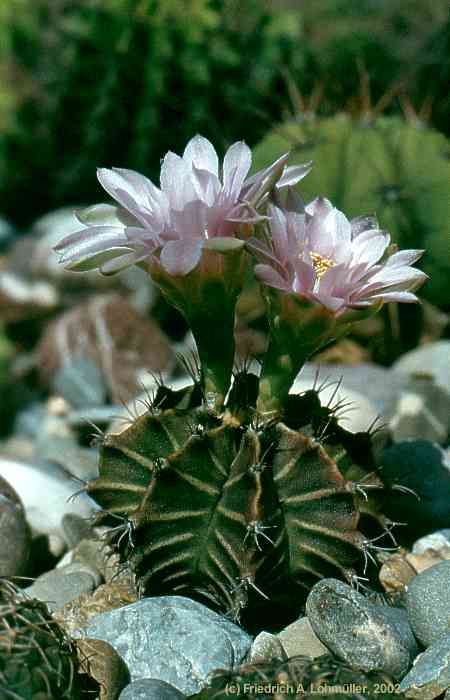 a diameter of 5 inches. All of the Gymnocalycium cactus have fairly large and showy flowers which are are white, yellow, orange and pink. The flowers are borne at the growing point of the cactus on short stems.
a diameter of 5 inches. All of the Gymnocalycium cactus have fairly large and showy flowers which are are white, yellow, orange and pink. The flowers are borne at the growing point of the cactus on short stems.Temperature
From September though May you will need to keep these desert cactus in a warm and sunny position avoiding only strong direct sunlight. From May onwards they benefit from being kept out of doors in a sheltered position where they will get full sun, some species will require light shade.
Pot Type
Gymnocalycium cactus are best grown in a terracotta type pot which should have at least one drainage hole in the base and it should be unglazed. This type of pot allows good drainage and allows the compost (therefor roots) to breath.
Watering
These plants should be kept moist at all times during the growing season which is April/May through September, water these plants every few days or every day in hot weather.
Lighting
 Grow Gymnocalycium cacti in full sun during the summer and winter, if kept too dark they may become overly lush and could be prone to rotting due to over watering, they will also be shy to produce flowers. Some of the species such as G. calochlorum, G. mihanovichii & G. oenanthemum will need some form of shading during the hottest hours of the summer.
Grow Gymnocalycium cacti in full sun during the summer and winter, if kept too dark they may become overly lush and could be prone to rotting due to over watering, they will also be shy to produce flowers. Some of the species such as G. calochlorum, G. mihanovichii & G. oenanthemum will need some form of shading during the hottest hours of the summer.
Feeding
If the compost is fresh then feeding may not be necessary at all, if the plant hasn't been repotted recently then half strength general purpose fertilizer can be used at watering time from May onwards once a month. Do not feed the plants from September onwards as this can cause lush growth which can be fatal during the darker cold months.
Repotting
Repotting should be done every other year or every three years, annual potting is not necessary. Remove the plant from its put by wrapping newspaper around the stem if it is very spiny. Carefully tap it out of the pot and remove the old compost to examine the roots, if any are damaged or showing signs of rotting they should be removed as close to the plant as possible.Re plant the cactus using the same mix of compost as it was originally in (fresh) and use a pot just slightly wider then the width of the cactus. Do not be tempted to over pot as this will cause the unused compost to go stagnant and you may loose the plant.